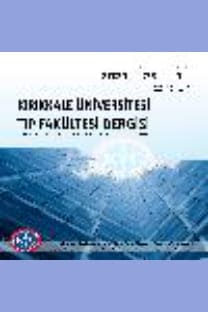İNTRAKRANİAL APSELERDE CERRAHİ TEDAVİ SONUÇLARI
Results of Surgical Treatment of Intracranial Abscess
___
- Rosenblum ML, Hoff JT, Norman D. Non-operative Treatment of Brain Abscess in Selected High-risk Patients. J Neurosurg. 1980; 52: 217-25.
- Macewen W. Pyogneic Infective Diseases of the Brain and Spinal Cord. GIascow J Maclehose and Sons 1893.
- Gowers WR, Baker JB. On a Case of Abscess of the Temporosphenoidal Lobe of the Brain due to Otitis media: Succesfully trcated with trepanation and Drainage. Br Med J.1986; 2: 1154-6.
- Dandy WE. Treatment of chronic abscess of the brain by tapping: Preliminary note. JAMA. 1926; 87: 1477-8.
- Vincent C. Sur une méthode de traitement des abcès subaigus des hémisphères cérébraux: large décompression, puis ablation en masse sans drainage. Gaz Méd de Fr. 1936; 43: 93-6.
- Rajshekhar V, Mathew CJ. Successful Stereotactic Management of a Large Cardiogenic Brain Stem Abscess. Neurosurgery.1984; 34: 368-71.
- Loftus CM, Osenbach RH, Beller J. Diagnosis and Management of Brain Abcess. In Wilkins RH, Rengachary SS(eds), Mc Graw Hill. Neurosurgery. 1996; 3: 3285-98.
- Jain KC, Varma A, Mahapatra AK. Pituitary abscess: a series of Six cases. Br J Neurosurg. 1997; 11(2): 139-43.
- Wispelwey B, Scheld WM. Brain abscess. In Mandell GL, Bennett JE, Dolin R (ed): Principles and Practice of Infectious Diseases, 4 th ed. New York: Churchill Livingstone. 1995: 887- 900.
- Kaplan K: Brain Abscess. Med Clin North Am. 1985; 69: 345-60.
- Chun HC, Johson JD, Hofstetter M. Brain Abscess: A study of 45 consecutive cases. Medicine. 1986; 65: 415-31.
- Young RF, Frazee J. Gas within intracranial abscess cavities: An indication for Surgical Excision. Ann Neurol. 1984; 16: 35-9.
- Yang SY. Brain Abscess: A review of 400 cases. J Neurosurg. 1981; 55: 794-9.
- Osenbach RK, Loftus CM. Diagnosis and Management of Brain Abscess. Neurosurg Clin North Am. 1992; 3: 403-20.
- Heineman HS, Braude AI, Osterholm JL. Intracranial Suppurative Disease. JAMA. 1971; 218: 1542-7.
- Bavetta S, Paterakis M, Srivatsa SR, Garvan N. Brainstem Abscess: Preoperative MRI appearance and survival following stereotactic aspiration. J Neurosurg Sci. 1996; 40: 139-43.
- Chacko AG, Chandy MJ. Diagnostic and staged stereotactic aspiration of multipl bihemispheric pyogenic brain abscess. Surg Neurol. 1997; 48: 278-82.
- Rish BL, Caveness WF, Dillon JD. Analysis of brain abscess after penetrating craniocerebral injuries in Vietnam. Neurosurgery. 1981; 9: 535-41.
- Yamamoto M, Fukushima T, Hirakawa K. Treatment of Bacterial Brain Abscess by Repeated Aspiration-Follow up by serial computed tomography. Neurol Med Chir (Tokyo). 2000; 40 (2): 98-104.
- ISSN: 2148-9645
- Yayın Aralığı: 3
- Başlangıç: 1999
- Yayıncı: KIRIKKALE ÜNİVERSİTESİ KÜTÜPHANE VE DOKÜMANTASYON BAŞKANLIĞI
ANKİLOZAN SPONDİLİTLİ GEBEDE ANESTEZİ YÖNETİMİ
KRONİK OBSTRÜKTİF AKCİĞER HASTALARINDA ANKSİYETE VE DEPRESYONUN BİLİŞSEL DURUMA ETKİSİ
YELİZ AKKUŞ, ELANUR YILMAZ KARABULUTLU, Selin YAĞCI
İNTRAKRANİAL APSELERDE CERRAHİ TEDAVİ SONUÇLARI
ACİL ÜNİTESİNE KAFA TRAVMASI NEDENİ İLE BAŞVURAN OLGULARIN DEĞERLENDİRME SONUÇLARI
HİPEREMEZİS GRAVİDARUM ETYOLOJİSİNDE PSİKOLOJİK KOMPONENT: KRİTİK BİR DERLEME
İNTRAKRANİYAL ABSELERDE CERRAHİ TEDAVİ SONUÇLARI
HASTANE İÇİ VE ACİL SERVİS KARDİYOPULMONER RESÜSİTASYONLARININ KARŞILAŞTIRLMASI
YÜCEL YÜZBAŞIOĞLU, HÜSEYİN CAHİT HALHALLI, Gökçen HALHALLI, Osman ESEN, Hayrunisa ESEN, Meral YILDIRIM, Yavuz Selim DİVRİKOĞLU, SERKAN YILMAZ
KRONİK OBSTRÜKTİF AKCİĞER HASTALARINDA (KOAH) ANKSİYETE VE DEPRESYONUN BİLİŞSEL DURUMA ETKİSİ
Yeliz AKKUŞ, Elanur YILMAZ KARABULUTLU, Selin YAĞCI
ENDODONTİDE KONİK IŞINLI BİLGİSAYARLI TOMOGRAFİNİN KULLANIMI
Yasemin AYDIN YILMAZ, Hayri RAMADAN, HANDAN ÇİFTÇİ, Aylin ERKEK, SEVİLAY VURAL, FİGEN ÇOŞKUN
